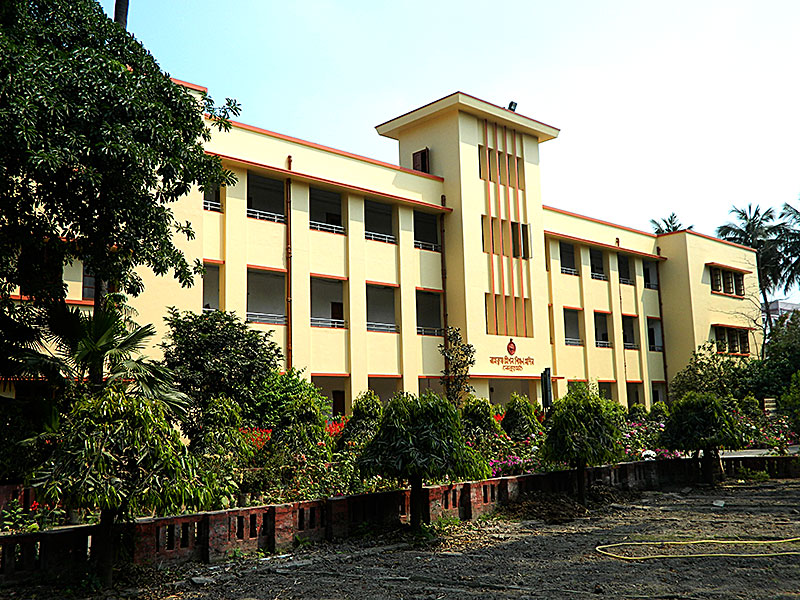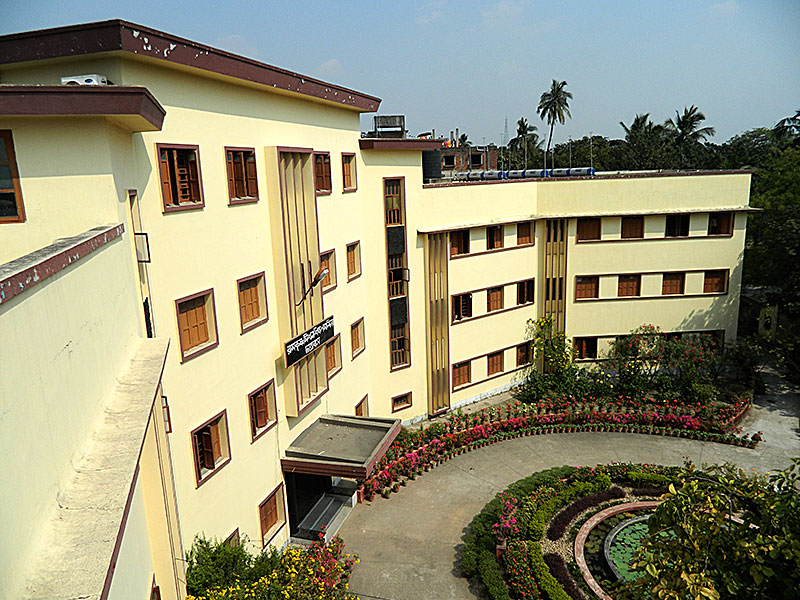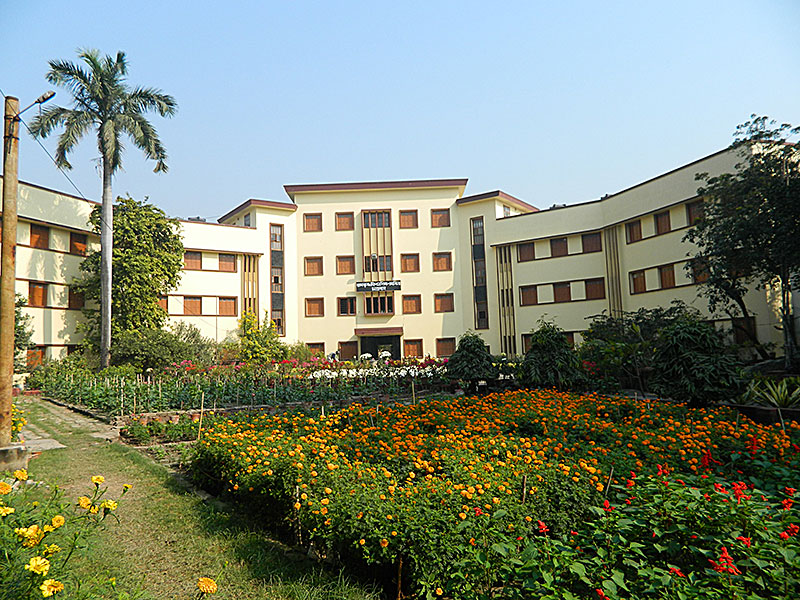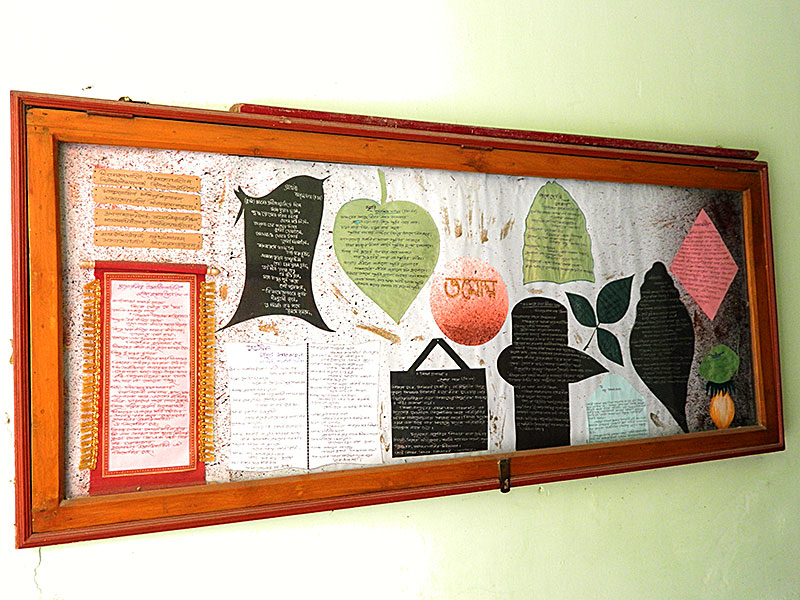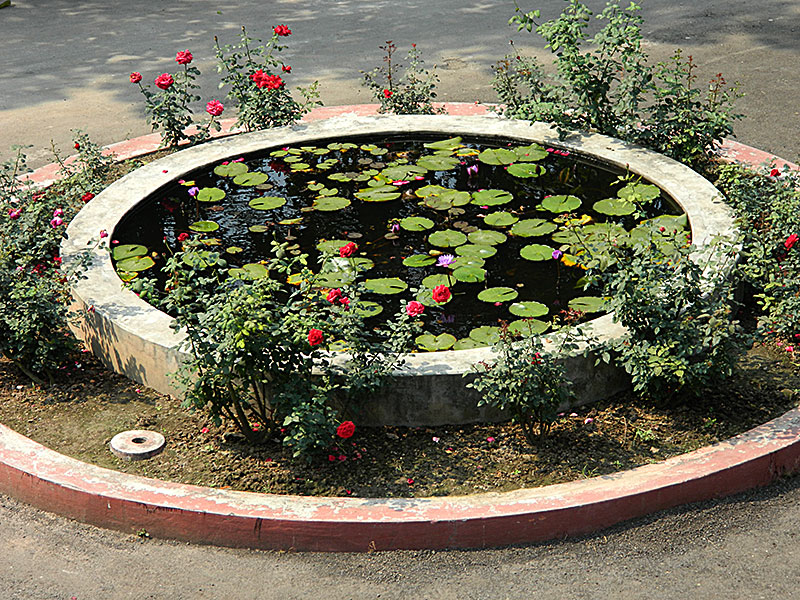INTRODUCTION
“Education is the manifestation of the perfection already in man.” – Swami Vivekananda
At the culmination of Swami Vivekananda’s spiritual odyssey of Bhaarat Darshan, his accumulated experiences made him aware of the treasures of Indian culture hidden behind the misery and poverty of contemporary society. Swamiji perceived that the acute suffering and the repression of the smoldering identity of our great nation beneath that is a direct consequence of absence of education in its purest form. Thereafter he lived and preached the paramount significance of education and educators in building the character of an individual that is infallible, pure, and rekindled with the idea of sacrifice for the common good.
In keeping with the guiding principles of Swamiji, Sikshanamandira was established in 1958 to instill values, competency, and integrity to the future generation of teachers and teacher-educators and to set an example of teaching at its pinnacle.
Located amidst a serene and picturesque ambiance, in close proximity of the sacred precincts of Belur Math, Sikshanamandira, is at a distance of about one furlong to the west of the river Ganga and about two furlongs to the east of the Grand Trunk Road and is conveniently accessible by Bus Service to Howrah Station and Vivekananda Setu, by railway service from two local stations, and by ferry service on Hooghly River.
Vision:
Sikshanamandira aspires to be a pioneer in teacher education with an aim to actualize Swami Vivekananda's educational vision through the pursuit of excellence in the field of teacher education and fundamental research. Our resolution is to impart a unique blend of modern educational approach and traditional values to future teachers and teacher educators to equip them with the knowledge necessary to face the changing social needs through the discovery, development, and proper implementation of acquired knowledge.
Mission:
Our mission is to realize our vision by:
-
Preparing teachers and curriculums that reflects a contemporary approach imbued with India’s rich heritage of cultural and spiritual values.
-
Facilitating trailblazing research in the field of teacher education and innovative practices with methodical circulation and publication of the results in the academic circle.
-
Promoting scholarly research as well as physical and mental wellbeing through M. Phil, Ph. D and Diploma programmes.
-
Exploring interdisciplinary and multi-disciplinary approaches in the field of academia and research.
-
Cooperating and collaborating with other esteemed national and international institutions with similar objectives.
Goals and Objectives:
-
To develop new academic programmes and to revise the existing programmes to keep pace with the changing socio-economic-moral scenario.
-
To create appropriate ICT infrastructure supportive of academic and administrative needs.
-
To conduct In-service and Pre-service teacher education programmes to boost the coherence and productivity of prospective educators.
-
To develop and exhibit learning-teaching materials and ICT materials.
-
To promote computer competency among students, faculty, and staff.
-
To provide consultancy, guidance, and counseling services.
-
To create awareness about the student support services, policies, and campus events among students.
-
To support and encourage staff in their journey of personal and academic growth.
-
To promote community services, extension activities, co-curricular activities, projects with an aim to make a better society.
-
To promote and maintain communication, cooperation, and shared decision making among various departments, backed by an integrated and user-friendly management information system.
-
To ensure that the institutional values and standards meet the highest standards envisioned by our founders.
Values:
-
Truth - in the pursuit, generation, dissemination, and application of knowledge.
-
Freedom - of thought and expression
-
Respect - for diversity and the dignity of the individual
-
Responsibility - as towards the environment and citizens of the world.
-
Excellence - in intellectual, personal, and operational endeavours.
-
Integrity - in character and knowledge.
-
Innovation - in thinking and application.
The College: at a glance:
-
Established in 1958 by Srimat Swami Vimuktanandaji Maharaj (one of the architects for actualizing the educational vision as was envisaged by Swami Vivekananda), as a Residential Teachers’ Training College for male students sponsored by the Govt. of West Bengal and affiliated to the University of Calcutta.
-
Recognized by the National Council for Teacher Education in the year 2002-03 (as per the NCTE Regulations 2014, the present intake capacity for the B.Ed. programme is 100 for a year and for M.Ed. it's 50).
-
Declared as a College of Teacher Education (CTE) by the Ministry of Human Resource Development, Govt. of India in the year 2001.
-
First accreditation by the National Assessment and Accreditation Council (NAAC) in 2007 with ‘A’ grade.
-
Upgraded into a post graduate College by the NCTE in the year 2008 (as per the NCTE Regulations 2014, the present intake capacity for the M.Ed. programme is 50 for a year).
-
On the recommendations of the University Grants Commission, the University of Calcutta conferred the status of an Autonomous College in favour of this institution in 2008.
-
M.Phil. Programme in Education was initiated in the year 2012-13.
-
Post-graduation Diploma in Guidance and Counselling Course started in the year 2013.
-
Started Swami Vivekananda Centre for Multidisciplinary Research in Educational Studies (SVCMRES) a research wing under the University of Calcutta in 2014.
-
Re-Accredited by the National Assessment and Accreditation Council (NAAC) in 2015 with an ‘A’ grade.
-
Extension of Autonomous Status for another six years conferred on 2015.
-
Started Postgraduate Diploma in Yoga Education and Certificate Course in Communicative English and Writing in 2016.
-
Awarded the status of College with Potential for Excellence (CPE) by the UGC in 2016.
-
Selected by the UGC as a mentor institution under PARAMARSH Scheme in 2019 for mentoring NAAC Accreditation aspiring institutions to promote quality assurance in higher education.
Here is a Brief History of The College:
Sikshanamandira came into being in 1958 as the third Teachers’ Training College of West Bengal. The first prospectus depicts in its own language, the aim of this college:-
“To train teachers so as to make them fit instruments for imparting the right type of education to the younger generation of education. The enterprise is a step towards the realization of a big educational scheme of the Ramakrishna Mission Saradapitha. The Sikshanamandira has been made wholly residential to enable the trainees to live a community life for imbibing a spirit of service and mutual cooperation, learn self help and pay individual attention to their studies”. Swami Vivekananda said: “My idea of education is personal contact with the teacher - ‘Gurugriha Vasa’. Without the personal life of a teacher there would be no education. Take your Universities. What have they done during the fifty years of their existence? They have not produced one original man. They are merely an examining body. The idea of the sacrifice for the common well is not yet developed in our nation. One should live from his very boyhood with one whose character is like a blazing fire and should have before him a living example of the highest teaching” (My India, The India Eternal , p.-56).
Now to meet this aim the Sikshanamandira was framed as a residential college for the teacher community to be nurtured with Swamiji’s ideas on education. It is needless to say that the responsibility goes out-right with the teachers to train the future generation of a race up.
Swami Vimuktananda (Upen Maharaj), a visionary monk of the Ramakrishna order, was the first one to start with the ideas of today’s Saradapitha. He actually started from the scratches, and toiled beyond our fancy to realize his visions. Vimuktanandaji’s was the life in which the ideals of ‘Karma Yoga’, as propounded by Vivekananda, found its true medium of translation. A senior monk recapitulates: “Swami Vimuktanandaji once asked us, ‘which stage, do you think, of work helps us to purify our mind?’ We answered, ‘The infantile stage, of course’. In reply he said, ‘Yes, the infantile stage truly educates us, but there is a stage more important than it. Suppose we have resolved for a work and it is yet to start - that particular phase of oscillation provides us more dependence on God, more calmness of mind, and more negation of the idea of doer-ship. And again you must know this phase really helps us to attain the purity of mind , which Swamiji declares as the aim of Karma Yoga”.
His realization surely makes us aware of his struggle with the adversities in unfolding the scheme of Saradapitha. An unique loving soul as he was, Upen Maharaj always would shower his love and affection to each and every one. After a former student of Sikshanamandira (presently a monk of this order): “He was truly a master of all trades. In the field of work he was a Hercules, as it were. He was able to fuse developments of head, heart and hand within himself. For the sake of work different types of personalities would daily visit him; but none was there without being moved by his serene behaviour. It is not that strictness was unknown to him; but that was very much for the time being. Like an incense stick he burnt himself and towards the directions diffusing its fragrance, sweet and pure.”
Most Rev. Swami Virajanandaji, the Sixth-President of the order once remarked, “Swamiji has totally taken over Upen”. Perhaps, for this reason, Upen Mj. felt an irresistible urge to set a Teachers’ Training College up to accelerate the moderate formation of our future generation. The Belur Math authority, also, showed their interest, and a decision was taken that according to the sponsored scheme of the West Bengal Government the progression should be headed. It was 1957, and nobody was there ready at hand to assist Upen Mj. in this project. But an indomitable spirit as he was, Maharajji firmly resolved to start the academic activities of the proposed college sharply from the month of July of the forthcoming session. He never thought to limit the whole training project, only within the academic areas; the trainees should reside in the hostel adjacent to be acquainted with the character building idea of Swamiji, was his dream. But unfortunately the selected land appeared as the first impediment before him; because, at that time the landscape was rather marshy, full of bogs and ponds, some portion of it was covered with long grasses and remaining were fields. In those days considerable was the threat of the shortage of funds but his zealous nature dared to ignore it and started taking necessary steps to overcome the land.
The Holy Birth Anniversary of Swamiji, eventually, coincided with the 12th January in the year 1958. On that very occasion, Rev. Swami Visuddhanandaji, the then Vice-President of the Ramakrishna order, laid the foundation stone of the proposed college. Rev. Swami Madhavanandaji, the then General Secretary, with many other monks and dignitaries attended the ceremony. A small discussion session was, also, conducted. Personalities like Dr. Kalidas Nag, Sri Saila Kumar Mukhopadhyay and many other distinguished persons, in that session, discussed the Nation’s need for the trained teachers in translating into concrete the educational-objectives as propounded by Swami Vivekananda. Towards the end of the session all were at sea about selecting a suitable name for the institution. Swami Madhavananda wanted to have similarity with names of the other institutions under Saradapitha, and at length ‘Sikshanamandira’ was his proposal. The befitting nature of the new name, in fact, found everybody happy, especially Upen Mj.
Now, the construction of the proposed college-building should have to be finished within the limited time, and to meet the challenge, the progression was also quick. Swami Digananda (Parvati Mj.) had to exhaust himself to what extent day and night, as he was supervising the project—unimaginable, it appears today, to us.
With all its grandeur approached 14th July in the year 1958. Most Rev. Swami Visuddhanandaji Maharaj with his own hands, inaugurated the new college-building. At first the main gate-way was from the south; but now-a-days it overlooks the west. The change was inevitable for many an inconvenience—one of them was the hostel-block which at present is in the northward but in those days was thought to be erected in the southern piece of ground. However, the inaugural worship, rituals and homa were conducted in the big hall of the 1st floor of the college-edifice.
Sikshanamandira started its academic journey from the 4th of August. On that very day, too, on the eve of the classes, a nice small congregation was called for under the presidency of Rev. Swami Shasvatanandaji. Many distinguished monks, personalities and faculties from the various academic branches actually blessed the newcomer trainees with their serene presence.
But how was the picture of the total accommodations within the sole college building? It will be clearer if we start with the ground floor in which is situated today’s Library department, and in those days the big hall was partitioned to turn it into hostel facilities temporarily. Laboratories, Classrooms, Teachers’ Room etc., were also arranged in other rooms in the same floor. Kitchen, Dining Hall etc. were also temporarily accommodated in a small erection under thatched shade. For almost one year the Principal's office, Library and some Classrooms also took shelter in today’s Shanti Bhavan. Which is an obligatory for hostel life, the prayer hall, too, was situated in the Shantibhavan having the Holy Trio within its heart. Thus a great dream was headed to unfurl itself from almost a scratchy bubble.
Upen Mj. himself accompanied with his grateful heart Most Rev. Swami Visuddhanandaji Mj. from the Belur Math in a car for the inauguration of the new prayer hall. Some respected senior monks were also invited. A senior monk recollected some of the events of that day: “We all greeted Maharajji as the car stopped in front of the main gate-way. Upen Mj. was the first person to come out from the car followed by Rev. Visuddhanandaji and then followed the other senior monks. What a beautiful scene that was! all stood still awhile and with their appreciating eyes they scrutinized the scenery around. Before them was the newly elected edifice of Sikshanamandira and beyond it and all around was the background of an open green glade. One of the senior monks burst out with joy: “Ah! Upen, you have really cast a spell! What a drastic change, have you brought this waste land!” I noticed Rev. Visuddhanandaji shivered as those words got in his ears—his face became grave and reddish. And I heard him saying with a clear tinge of vexation in his voice, ‘What a shallow idea! don’t you know that His wish guides everything. It is better to say that Sri Sri Thakur Himself has brought beauty to this landscape.’ A little pause — and then with an extremely absorbed mind again and again he said, ‘Why will it not be so? He is the true beauty behind the beauty—a mere touch of His and everything is more beautiful. He is the Greatest—anything belongs to Him bears the mark of greatness—any work associated with His name must be a great work. Wherever His manifestation is executed—everything in that place bears the sign of beauty and greatness. Such is the glory of the Lord. Why do you bewilder? Instead you say, through Upen Sri Sri Thakur is doing all these things. Moreover, everything does not end with today. The far future will bring a great many things into existence. The Greatest and Infinite is our Lord—and His manifestations too are unimaginable. This college and the other things are just pieces of His manifestation. Therefore I prefer to say that Sri Sri Thakur has done everything and Upen has been the perfect instrument”.
When the chance came, the Prayer-hall was shifted to the main college building and from then onwards conduction of daily prayer, Bhajan, Patha etc. were in a normal procedure. All the residents including the students and staff of the hostel and the teachers, who would live in the hostel, used to attend the morning and evening prayers regularly. And the Prayer-hall, too, was so meticulously maintained that for everybody it was the place to regain mental peace and happiness. Many of the professors and students would visit the Prayer-hall, even, before the college hour daily. As, Sri Ramakrishna himself was the embodiment of ‘Sarva Dharma Samanvaya’ — the outlook of synthesis and generosity prevailed the mood of prayer, positively, in the Prayer-hall; because, reading of the excerpts from almost all major religious-books of all the religions for few minutes was mandatory. In those days Sikshanamandira used to observe Swamiji’s birth anniversaries every year and as a part of it educational exhibitions of very high standard used to be organised. Those exhibitions would last for a week and thousands of visitors would gather to be enriched in various ways. On such a day a devastating fire broke out in the main college building. From the memory of an eye-witness we can describe the night briefly: “An evening we have just called it a day and the exhibition-rooms have been closed — suddenly someone noticed smoke coming out from the first floor rooms of the college building. We all gathered there and were assuming the happenings inside, and then to our utter surprise we saw conflagration peeping out from the windows. Immediately the door was unlocked to find the science exhibition hall was under dangerous fire. All the equipment and furniture behind the fire-wall being crushed and burnt mercilessly. As the fire from the room also started venturing into the other rooms, all the first floor rooms were set ablaze. Everyone was under the impression that a mishap in the electric conductors might have been the cause. The fire brigade mediated within almost no time and four of their engines struggled hard for four hours to gain very little ground till midnight. The whole building remained impossible to touch for others due to intolerable smoke and scorching heat.
Now here was an incident that nobody even calculated. The neighbouring room of the science exhibition hall was the Prayer-hall. Nobody even fancied the condition that on the wooden altar there were the images of the Holy Trio, or from the walls hanging were the pictures of the saints and spiritual teachers. At about dawn when the fire had been extinguished we all with tears in our eyes discovered the whole of the exhibition set-up as well as the Prayer-hall to be reduced into ashes. However when the fire appeased itself, in the Prayer-hall pictures of the walls were recovered from the heaps of the ashes; and what a marvel — the wooden frames and glasses as well had no chance to survive, but photos were as usual and untouched by fire! It seemed to us almost miraculous because the high heat actually deformed and melted all the brass and copper vessels. Another unimaginable sight was waiting for us — the altar and throne of Sri Sri Thakur made of tick-wood still unburnt and untouched! But what about the image of Sri Sri Thakur?—he was nowhere before our eyes. We could think no more. In the meantime someone announced, ‘I’ve got it, I’ve found it’. A fellow student was sobbing in his own room embracing the image within his own arms. Afterwards, we came to know that ignoring the fire the student entered the Prayer-hall to remove the image. In fact he at that unfortunate night saved our heart. And with the first rays of the sun the indomitable Sikshanamandira again gathered in the ground floor hall for the ‘Morning Prayer’ before the same living image of Sri Ramakrishna!”
With the passing years as the periphery of functions were increasing a dire need for a separate hostel accommodation was also pressing hard. The 13th January of 1966 marks the day of installing foundation stone for the separate hostel building. Rev. Swami Santanandaji laid the stone and many of the senior monks from Belur Math attended the ceremony. The huge building took almost one and half year to be worthy for the purpose, and, at last, on the 5th July, 1967, Most Rev. Swami Vireswaranandaji, the then President of the order blessed it on the occasion of its inaugural ceremony. Thus, from July of 1967 the Sikshanamandira emerged as a complete infrastructure with a residential facility for 200 students. The entire college building, from then on, remained only for the college; the big hall in the 2nd floor was named as the ‘Vivekananda Mandap’, and its counterpart in the 1st floor, serving erstwhile the purpose of the Prayer-hall for the hostel, was renamed as the ‘Ramakrishna Hall’.
Swamiji said “At present we need ‘Gurugriha Vasa’ — the same way as of old. But with this education has to be combined with modern western sciences. Both these are necessary — mind it — Vedanta has to be combined with Western Science. The guiding motto should be Brahmachrya and also Shraddha and faith in one’s own self. Independently, English and Science should be taught with the traditional education of our country.” The aim of the Institution according to the prospectus of the session 2005-06 also echoes the same idealism: “The aim of the Sikshanamandira is to train teachers who will harmonize professional competence with high idealism and seek to implement the educational vision of Swami Vivekananda in a practical manner. To implement Swamiji’s ideal of man-making and character-building education, the nation needs teachers who are equipped with a modern outlook in the tools and techniques of education and yet, are rooted in Indian cultural, moral and spiritual values. The Sikshanamandira aims at attaining this result by blending the regular teacher training course with practices based on Indian values'.
From the very beginning of this century the Sikshanamandira has been trying its best to attend to the goal, through various means of modernisation. Laboratories for Language, Psychology, History and Mathematics have been furnished. The Computer Laboratory has been totally remodeled, and all the departments are now equipped with all modern facilities such as wifi and various other technological and digital advancements. The Library too not remained neglected.
Furthermore, it is worth mentioning that a Journal 'Samskrtacintanam’ (ISSN: 2393-8641) - a research journal on Sanskrit Language being published since 2014, has been included in the UGC Care List since January, 2023.

